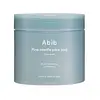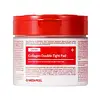What's inside
What's inside
 Key Ingredients
Key Ingredients

 Benefits
Benefits

 Concerns
Concerns

 Ingredients Side-by-side
Ingredients Side-by-side

Water
Skin ConditioningButylene Glycol
HumectantPinus Densiflora Leaf Extract
AntimicrobialGlycerin
HumectantAlcohol
Antimicrobial1,2-Hexanediol
Skin ConditioningPaeonia Suffruticosa Root Extract
Skin ProtectingCentella Asiatica Extract
CleansingChamomilla Recutita Flower Extract
MaskingGlyceryl Caprylate
EmollientBetaine
HumectantPolyglyceryl-10 Laurate
Skin ConditioningPanthenol
Skin ConditioningEthylhexylglycerin
Skin ConditioningSodium Citrate
BufferingGluconolactone
Skin ConditioningCapryloyl Salicylic Acid
ExfoliatingTromethamine
BufferingCitric Acid
BufferingDiethylhexyl Sodium Sulfosuccinate
CleansingSodium Hyaluronate
HumectantPantolactone
HumectantDipropylene Glycol
HumectantEpilobium Fleischeri Extract
Skin ConditioningPinus Palustris Leaf Extract
TonicOenothera Biennis Flower Extract
AstringentUlmus Davidiana Root Extract
Skin ConditioningPueraria Lobata Root Extract
HumectantPotassium Sorbate
PreservativeDisodium EDTA
Water, Butylene Glycol, Pinus Densiflora Leaf Extract, Glycerin, Alcohol, 1,2-Hexanediol, Paeonia Suffruticosa Root Extract, Centella Asiatica Extract, Chamomilla Recutita Flower Extract, Glyceryl Caprylate, Betaine, Polyglyceryl-10 Laurate, Panthenol, Ethylhexylglycerin, Sodium Citrate, Gluconolactone, Capryloyl Salicylic Acid, Tromethamine, Citric Acid, Diethylhexyl Sodium Sulfosuccinate, Sodium Hyaluronate, Pantolactone, Dipropylene Glycol, Epilobium Fleischeri Extract, Pinus Palustris Leaf Extract, Oenothera Biennis Flower Extract, Ulmus Davidiana Root Extract, Pueraria Lobata Root Extract, Potassium Sorbate, Disodium EDTA
Water
Skin ConditioningButylene Glycol
HumectantHydrolyzed Collagen
Emollient1,2-Hexanediol
Skin ConditioningGlycerin
HumectantIsopropyl Palmitate
EmollientArginine
MaskingLactobacillus Ferment
Skin ConditioningPrunus Amygdalus Dulcis Oil
Skin ConditioningAcrylates/C10-30 Alkyl Acrylate Crosspolymer
Emulsion StabilisingCarbomer
Emulsion StabilisingPolyglyceryl-10 Laurate
Skin ConditioningDiospyros Kaki Leaf Extract
Skin ProtectingVitis Vinifera Fruit Extract
Skin ConditioningMentha Arvensis Leaf Oil
MaskingCarthamus Tinctorius Flower Extract
Skin ConditioningCoffea Arabica Seed Extract
MaskingPolygonum Cuspidatum Root Extract
AntioxidantCamellia Sinensis Leaf Extract
AntimicrobialCastanea Crenata Shell Extract
Skin ConditioningZanthoxylum Piperitum Fruit Extract
Skin ConditioningLactococcus Ferment
Skin ConditioningBifida Ferment Filtrate
Skin ConditioningBarosma Betulina Leaf Extract
PerfumingDisodium EDTA
Polyquaternium-51
Skin ConditioningRosa Damascena Flower Water
MaskingSodium Hyaluronate
HumectantGluconolactone
Skin ConditioningOenothera Biennis Flower Extract
AstringentPinus Palustris Leaf Extract
TonicPueraria Lobata Root Extract
HumectantUlmus Davidiana Root Extract
Skin ConditioningEthylhexylglycerin
Skin ConditioningGlycine
BufferingSerine
MaskingGlutamic Acid
HumectantAspartic Acid
MaskingLeucine
Skin ConditioningAlanine
MaskingLysine
Skin ConditioningTyrosine
MaskingPhenylalanine
MaskingThreonine
Valine
MaskingProline
Skin ConditioningIsoleucine
Skin ConditioningDipeptide Diaminobutyroyl Benzylamide Diacetate
Skin ConditioningHistidine
HumectantMethionine
Skin ConditioningCysteine
AntioxidantPalmitoyl Tripeptide-5
Skin ConditioningHydrolyzed Hyaluronic Acid
HumectantSodium Acetylated Hyaluronate
HumectantWater, Butylene Glycol, Hydrolyzed Collagen, 1,2-Hexanediol, Glycerin, Isopropyl Palmitate, Arginine, Lactobacillus Ferment, Prunus Amygdalus Dulcis Oil, Acrylates/C10-30 Alkyl Acrylate Crosspolymer, Carbomer, Polyglyceryl-10 Laurate, Diospyros Kaki Leaf Extract, Vitis Vinifera Fruit Extract, Mentha Arvensis Leaf Oil, Carthamus Tinctorius Flower Extract, Coffea Arabica Seed Extract, Polygonum Cuspidatum Root Extract, Camellia Sinensis Leaf Extract, Castanea Crenata Shell Extract, Zanthoxylum Piperitum Fruit Extract, Lactococcus Ferment, Bifida Ferment Filtrate, Barosma Betulina Leaf Extract, Disodium EDTA, Polyquaternium-51, Rosa Damascena Flower Water, Sodium Hyaluronate, Gluconolactone, Oenothera Biennis Flower Extract, Pinus Palustris Leaf Extract, Pueraria Lobata Root Extract, Ulmus Davidiana Root Extract, Ethylhexylglycerin, Glycine, Serine, Glutamic Acid, Aspartic Acid, Leucine, Alanine, Lysine, Tyrosine, Phenylalanine, Threonine, Valine, Proline, Isoleucine, Dipeptide Diaminobutyroyl Benzylamide Diacetate, Histidine, Methionine, Cysteine, Palmitoyl Tripeptide-5, Hydrolyzed Hyaluronic Acid, Sodium Acetylated Hyaluronate
Ingredients Explained
These ingredients are found in both products.
Ingredients higher up in an ingredient list are typically present in a larger amount.
1,2-Hexanediol is a synthetic liquid and another multi-functional powerhouse.
It is a:
- Humectant, drawing moisture into the skin
- Emollient, helping to soften skin
- Solvent, dispersing and stabilizing formulas
- Preservative booster, enhancing the antimicrobial activity of other preservatives
Butylene Glycol (or BG) is used within cosmetic products for a few different reasons:
Overall, Butylene Glycol is a safe and well-rounded ingredient that works well with other ingredients.
Though this ingredient works well with most skin types, some people with sensitive skin may experience a reaction such as allergic rashes, closed comedones, or itchiness.
Learn more about Butylene GlycolDisodium EDTA plays a role in making products more stable by aiding other preservatives.
It is a chelating agent, meaning it neutralizes metal ions that may be found in a product.
Disodium EDTA is a salt of edetic acid and is found to be safe in cosmetic ingredients.
Learn more about Disodium EDTAEthylhexylglycerin (we can't pronounce this either) is commonly used as a preservative and skin softener. It is derived from glyceryl.
You might see Ethylhexylglycerin often paired with other preservatives such as phenoxyethanol. Ethylhexylglycerin has been found to increase the effectiveness of these other preservatives.
Gluconolactone is a PHA. PHAs are a great gentle alternative to traditional AHAs.
When applied, Gluconolactone has the same affect on skin as AHAs such as lactic acid. It helps dissolve the dead skin cells in the top layer of your skin. This improves texture and brightens the skin.
PHAs are more gentle than AHAs due to their larger structure. They do not penetrate as deeply as AHAs and take a longer time to dissolve dead cells. Studies show PHAs do not cause as much irritation.
Gluconolactone has some interesting properties:
In a 2004 study, Gluconolactone was found to prevent UV damage in mouse skin cells and has not been found to increase sun sensitivity. However, we still recommend wearing SPF daily.
This ingredient is is an created by reacting gluconic acid with an alcohol.
Learn more about GluconolactoneGlycerin is already naturally found in your skin. It helps moisturize and protect your skin.
A study from 2016 found glycerin to be more effective as a humectant than AHAs and hyaluronic acid.
As a humectant, it helps the skin stay hydrated by pulling moisture to your skin. The low molecular weight of glycerin allows it to pull moisture into the deeper layers of your skin.
Hydrated skin improves your skin barrier; Your skin barrier helps protect against irritants and bacteria.
Glycerin has also been found to have antimicrobial and antiviral properties. Due to these properties, glycerin is often used in wound and burn treatments.
In cosmetics, glycerin is usually derived from plants such as soybean or palm. However, it can also be sourced from animals, such as tallow or animal fat.
This ingredient is organic, colorless, odorless, and non-toxic.
Glycerin is the name for this ingredient in American English. British English uses Glycerol/Glycerine.
Learn more about GlycerinWe don't have a description for Oenothera Biennis Flower Extract yet.
We don't have a description for Pinus Palustris Leaf Extract yet.
Polyglyceryl-10 Laurate is an ester of lauric acid and Polyglycerin-10.
Polyglyceryl-10 Laurate is a cleansing agent and emulsifier. It helps gather dirt, oil, and other pollutants to be rinsed away. As an emulsifier, it helps prevent ingredients from separating, such as oil and water.
Polyglyceryl-10 Laurate may not be fungal acne safe.
Learn more about Polyglyceryl-10 LaurateWe don't have a description for Pueraria Lobata Root Extract yet.
Sodium Hyaluronate is hyaluronic acid's salt form. It is commonly derived from the sodium salt of hyaluronic acid.
Like hyaluronic acid, it is great at holding water and acts as a humectant. This makes it a great skin hydrating ingredient.
Sodium Hyaluronate is naturally occurring in our bodies and is mostly found in eye fluid and joints.
These are some other common types of Hyaluronic Acid:
Learn more about Sodium HyaluronateThis tree is also known as the David Elm. It contains the ingredient bakuchiol.
Other great compounds found in this ingredient include galactose, glucose, and phenolics. The sugar content gives it great skin hydrating properties. Phenolics are potent antioxidants commonly found in fruits and veggies.
A 2020 study found the phenolics of this root to have an anti-inflammatory effect.
Fun fact: This ingredient is used in traditional Asian medicine.
Learn more about Ulmus Davidiana Root ExtractWater. It's the most common cosmetic ingredient of all. You'll usually see it at the top of ingredient lists, meaning that it makes up the largest part of the product.
So why is it so popular? Water most often acts as a solvent - this means that it helps dissolve other ingredients into the formulation.
You'll also recognize water as that liquid we all need to stay alive. If you see this, drink a glass of water. Stay hydrated!
Learn more about Water